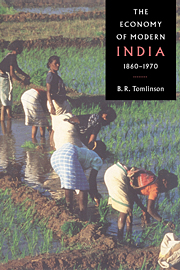Book contents
- Frontmatter
- 1 Introduction: development and underdevelopment in colonial India
- 2 Agriculture 1860–1950: land, labour and capital
- 3 Trade and manufacture, 1860–1945: firms, markets and the colonial state
- 4 The state and the economy, 1939–1970: the emergence of economic management in India
- 5 Conclusion
- Bibliographical essay
- Index
- THE NEW CAMBRIDGE HISTORY OF INDIA
- Map I.I India in 1937-8
5 - Conclusion
Published online by Cambridge University Press: 28 March 2008
- Frontmatter
- 1 Introduction: development and underdevelopment in colonial India
- 2 Agriculture 1860–1950: land, labour and capital
- 3 Trade and manufacture, 1860–1945: firms, markets and the colonial state
- 4 The state and the economy, 1939–1970: the emergence of economic management in India
- 5 Conclusion
- Bibliographical essay
- Index
- THE NEW CAMBRIDGE HISTORY OF INDIA
- Map I.I India in 1937-8
Summary
Between 1860 and 1970 the Indian economy was in an underdeveloped state, but the characteristics of this underdevelopment need to be specified with some care. The economy was not simply stagnant, neither was it incapable of growth, nor in a necessary preparatory stage for development in the future. In the aggregate there was a surplus above subsistence, leading to some capital investment, technical change and new organisational forms, but the dynamic forces thus generated were not strong enough to bring about sustained growth. The possibility of greater efficiency was too easily overwhelmed by the sheer size of the labour force, setting up a vicious circle of labour-intensive, low wage/low productivity processes in agriculture and industry, reinforced by a peasant form of social organisation that encouraged the self-exploitation of family labour. As a result, in the first half of the twentieth century productivity rose only slowly in industry, and little if at all in agriculture, while average per capita income stagnated and foodgrain availability fell significantly during the last three decades of colonial rule. Industrial output grew sharply in the first twenty years after Independence, but the policies needed to sustain this resulted in consistent balance of payments difficulties and a major agricultural crisis by the mid 1960s.
High man:land ratios and population densities do not by themselves explain the failure of development in South Asia. Indeed, the example of other Asian economies in the twentieth century suggests that high rates of labour availability can spur a broadly based and successful pattern of development provided that such labour is rewarded through a consistently high rate of productivity, a high rate of utilisation, and rising real wages.
Keywords
- Type
- Chapter
- Information
- The Economy of Modern India, 1860–1970 , pp. 214 - 218Publisher: Cambridge University PressPrint publication year: 1993



